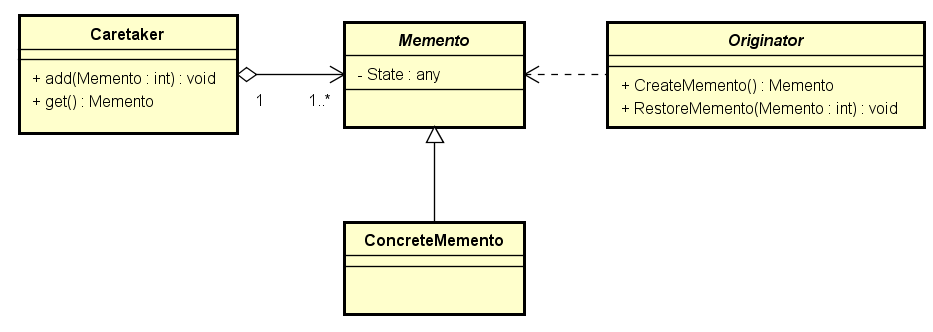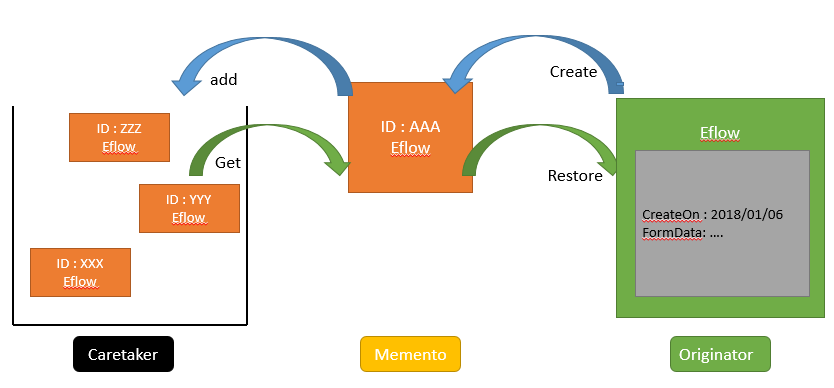Amy(PO):
As a 電子表單使用者
I want 系統可以在我填寫表單時,提供記錄草稿的功能,儲存該張表單後,即刪除該單所有草稿,但若未儲存,則須保留草稿
So that 避免臨時無法完成表單而造成已填寫之資料遺失情況
JB:
(打哈欠)這個User Story有點長,我總是記不住,我得重頭再看一次...
Lily:
你得有充足的睡眠! 避免像個鐵人一樣在半夜寫程式或寫文章! 好了,我建議用備忘錄解決這件事。
JB:
你說的沒錯,把一些重要的東西記在備忘錄,需要的時候就拿出來看...
Lily:
喔,我是指用設計模式:Memento,來解決這個Backlog,它提供了可以隨時儲存現在的狀態,和回復之前的狀態的行為模式。
在不違反封裝的原則下,取得一個物件的內部狀態並保留在外部,並提供對象恢復到其以前的狀態的能力 (WIKI)
在Memento中,定義了以下角色:

在這個例子,我們要放在備忘錄的目標是:電子表單,所以先建立如下之Model:
public class Eflow : ICloneable
{
public DateTime CreateOn { get; set; }
public string FormData { get; set; }
public object Clone()
{
//Implement deep clone here
}
}
import datetime
class Eflow:
def __init__(self, createOn=datetime.datetime, formData=""):
self.createOn = createOn
self.formData = formData
Memento即代表一份備忘錄,我們在這個備忘錄記錄我們想留存的東西;
以這個例子來看,我們要留存的是電子表單物件;為了區別每一份備忘錄,我們在備忘錄上也記錄一個唯一的序號(Id)。
public interface IMemento
{
string Id {get;set;}
}
public class EflowMemento:IMemento
{
public string Id {get;set;}
public Eflow Eflow {get;set;}
}
from abc import ABC, abstractmethod
from Models import Eflow
class Memento(ABC):
def __init__(self, id=""):
self.id = id
class EflowMemento(Memento):
def __init__(self, id="", eflow=Eflow):
self.id = id
self.eflow = eflow
Caretaker的職責就是提供一個可供存取備忘錄的容器和介面。
public class Caretaker
{
private IDictionary<string, IMemento> _store = null;
public Caretaker()
{
this._store = new Dictionary<string, IMemento>();
}
public void Add(string key, IMemento memento)
{
this._store.Add(key, memento);
}
public IMemento Get(string key)
{
if (this._store.ContainsKey(key))
{
return this._store[key];
}
else
{
return null;
}
}
}
class Caretaker:
def __init__(self):
self.store = {}
def add(self, key="", memento=Memento):
self.store[key] = memento
print("儲存一張表單! 建立日期{0},內容: {1}".format(
memento.eflow.createOn, memento.eflow.formData))
def get(self, key=""):
restoredMemento = self.store[key]
print("回存一張表單! 建立日期{0},內容: {1}".format(
restoredMemento.eflow.createOn, restoredMemento.eflow.formData))
return restoredMemento
Originator是主程式操作的對像,它擁有需要被記錄的資料,並且提供以下功能
public interface IOriginator
{
IMemento CreateMemento();
void RestoreMemento(IMemento memento);
}
public class EflowOriginator : IOriginator
{
private Eflow _eflow = null;
public Eflow Eflow
{
get { return this._eflow; }
set { this._eflow = value; }
}
/// 記錄目前狀態
public IMemento CreateMemento()
{
IMemento memento = new EflowMemento()
{
Id = System.Guid.NewGuid().ToString(),
Eflow = (Eflow)this._eflow.Clone()
};
return memento;
}
/// 回存舊的狀態
public void RestoreMemento(IMemento memento)
{
this._eflow = (memento as EflowMemento).Eflow;
}
}
import uuid
import copy
from abc import ABC, abstractmethod
class Originator(ABC):
@abstractmethod
def createMemento(self):
pass
@abstractmethod
def restoreMemento(self, memento= Memento):
pass
class EflowOriginator(Originator):
def __init__(self):
self.eflow = None
def createMemento(self):
uid = str(uuid.uuid4())
memento = EflowMemento(uid, copy.deepcopy(self.eflow))
return memento
def restoreMemento(self,memento=Memento):
self.eflow = memento.eflow
我以一張示意圖來表示以上的程式碼:

我們來看主程式的部分。
var caretaker = new Caretaker();
var originator = new EflowOriginator();
originator.Eflow = new Eflow{
CreateOn = DateTime.Now,
FormData = "簽呈:工程師Hachi申請加薪$3,000!"
};
//建立備忘
var memento = originator.CreateMemento();
//儲存備忘
caretaker.Add("Hachi的新年新希望" , memento);
//老闆收到電子表單,找Hachi約談並施展三寸不爛之舌,只同意加薪$30
originator.Eflow.CreateOn = DateTime.Now.AddMinutes(2);
originator.Eflow.FormData = "簽呈:工程師Hachi申請加薪$30!";
//建立備忘
memento = originator.CreateMemento();
//儲存備忘
caretaker.Add("Hachi的新年新希望v2" , memento);
//有新公司找Hachi過去,Hachi準備提離職,老闆趕緊同意先前條件
//Hachi調出之前該單的備忘回存
var mementoOld = caretaker.Get("Hachi的新年新希望");
originator.RestoreMemento(mementoOld);
caretaker = Caretaker()
originator = EflowOriginator()
originator.eflow = Eflow(
createOn = datetime.datetime.now(),
formData = "簽呈:工程師Hachi申請加薪$3,000!")
# 第一次建立備忘
memento = originator.createMemento()
# 第一次儲存備忘
caretaker.add("Hachi的新年新希望" , memento)
# 老闆收到表單,找Hachi約談並施展三寸不爛之舌,只同意加薪$30
originator.eflow.createOn = originator.eflow.createOn + datetime.timedelta(0,2)
originator.eflow.formData = "簽呈:工程師Hachi申請加薪$30!"
# 第二次建立備忘
memento = originator.createMemento()
# 第二次儲存備忘
caretaker.add("Hachi的新年新希望v2" , memento)
# 有新公司找Hachi過去,Hachi準備提離職,老闆趕緊同意先前條件
# Hachi調出之前該單的備忘回存
mementoOld = caretaker.get("Hachi的新年新希望")
originator.restoreMemento(mementoOld)
執行結果:
儲存一張表單! 建立日期2018/01/06 18:46:55,內容: 簽呈:工程師Hachi申請加薪$3,000!
儲存一張表單! 建立日期2018/01/06 18:48:55,內容: 簽呈:工程師Hachi申請加薪$30!
回存一張表單! 建立日期2018/01/06 18:46:55,內容: 簽呈:工程師Hachi申請加薪$3,000!
